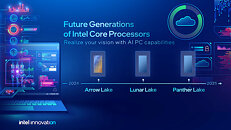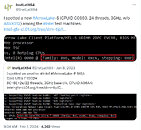T0@st
News Editor
- Joined
- Mar 7, 2023
- Messages
- 2,204 (3.21/day)
- Location
- South East, UK
An interesting Intel document leaked out last month—it contained detailed pre-release information that covered their upcoming 15th Gen Core Arrow Lake-S desktop CPU platform, including a possible best scenario 8+16+1 core configuration. Thorough analysis of the spec sheet revealed a revelation—the next generation Core processor family could "lack Hyper-Threading (HT) support." The rumor mill had produced similar claims in the past, but the internal technical memo confirmed that Arrow Lake's "expected eight performance cores without any threads enabled via SMT." These specifications could be subject to change, but tipster—InstLatX64—has uprooted an Arrow Lake-S engineering sample: "I spotted (CPUID C0660, 24 threads, 3 GHz, without AVX 512) among the Intel test machines."
The leaker had uncovered several pre-launch Meteor Lake SKUs last year—with 14th Gen laptop processors hitting the market recently, InstLatX64 has turned his attention to seeking out next generation parts. Yesterday's Arrow Lake-S find has chins wagging about the 24 thread count aspect (sporting two more than the fanciest Meteor Lake Core Ultra 9 processor)—this could be an actual 24 core total configuration—considering the evident lack of hyper-threading, as seen on the leaked engineering sample. Tom's Hardware reckons that the AVX-512 instruction set could be disabled via firmware or motherboard UEFI—if InstLatX64's claim of "without AVX-512" support does ring true, PC users (demanding such workloads) are best advised to turn to Ryzen 7040 and 8040 series processors, or (less likely) Team Blue's own 5th Gen Xeon "Emerald Rapids" server CPUs.



View at TechPowerUp Main Site | Source
The leaker had uncovered several pre-launch Meteor Lake SKUs last year—with 14th Gen laptop processors hitting the market recently, InstLatX64 has turned his attention to seeking out next generation parts. Yesterday's Arrow Lake-S find has chins wagging about the 24 thread count aspect (sporting two more than the fanciest Meteor Lake Core Ultra 9 processor)—this could be an actual 24 core total configuration—considering the evident lack of hyper-threading, as seen on the leaked engineering sample. Tom's Hardware reckons that the AVX-512 instruction set could be disabled via firmware or motherboard UEFI—if InstLatX64's claim of "without AVX-512" support does ring true, PC users (demanding such workloads) are best advised to turn to Ryzen 7040 and 8040 series processors, or (less likely) Team Blue's own 5th Gen Xeon "Emerald Rapids" server CPUs.



View at TechPowerUp Main Site | Source





